




| Home | Features | Club Nights | Underwater Pics | Feedback | Non-Celebrity Diver | Events | 31 July 2025 |
| Blog | Archive | Medical FAQs | Competitions | Travel Offers | The Crew | Contact Us | MDC | LDC |

|

|
 
 |
 ISSUE 16 ARCHIVE - COOKING THE CATCH: SEARED SCALLOPS WITH CARROT FRITTERSAndrew MaxwellSeared Scallops with Carrot Fritters and Yoghurt DressingServes 4. For the scallops:
For the carrot fritters:
For the yoghurt dressing:
To make the carrot fritters:Pre-heat the oven to gas mark 2, 150oC. Sift the flour, cumin, coriander, turmeric and salt into a mixing bowl, make a well in the centre and add the soda water and egg. Mix well. Add the finely chopped chilli, grated carrot, spring onion and fresh coriander, stir well together. Heat a frying pan, add the oil and when hot cook the fritters in batches using two tablespoons of batter for each fritter. They should be cooked for 2 minutes on each side or until golden brown. Drain on kitchen paper; add a little more oil to the pan if needed. Keep the fritters warm on kitchen paper in the oven whilst you cook the scallops. For the scallops:Place the scallops in a bowl with the olive oil, season with salt and black pepper and mix well. Heat a non-stick pan and cook the scallops for barely a minute on each side. For the yoghurt dressing:Place all the ingredients in a bowl and mix well to combine. To serve:Place 3 carrot fritters on an individual plate with 3 scallops and some watercress. Drizzle with some yoghurt dressing and serve at once. Scallop Producers Take the Hit with EU RulesGood news on the 'sustainability' front... There are now something in the region of 1,000 products that are officially certified as sustainable by the Marine Stewardship Council (MSC). An increase of nearly 45%. This is great news for consumers, so remember to look out for the little blue MSC logo on fish products in the shops. There’s bad news too I’m afraid, and once again we have the ‘suits’ in Brussels to thank for it, (because they are experts in this particular field, of course). The Summary:The EU have reinforced a regulation that means that scallop suppliers have to ‘shuck’ the scallops before shipping them out to consumers. This means that it is technically impossible to buy live scallops in their shells. The Detail:In 1987 a group of people in Canada contracted Amnesic Shellfish Poisoning (ASP), from mussels. This outbreak prompted the EU to set ‘toxicity levels’ in bivalvia such as oysters, mussels and scallops at a blanket rate of 20mg/ kg. The toxins are found in the guts of these shellfish, however the legislation does not allow for the fact that oysters and mussels are eaten whole whereas with scallops, the guts are removed before consumption. The effect of these rules is that scallops have to be removed from their shells, have the guts removed and then put back into their shells before they can be shipped out to restaurants or fishmongers. “What’s wrong with that?” I hear you ask? Well, the problem is two-fold. Firstly, it means that it is very hard to prove the provenance of scallops – I’m sure you have all heard me shouting from my soap box about the difference between diver caught scallops and dredged scallops... With the former, the scallops are generally still alive when they arrive in the kitchen – you can see how fresh they are and the suppliers cannot lie about their provenance. But if the scallop is shucked at source, it could have been out of the water for days and days before it gets to market... it might not actually even be a diver caught scallop. These are considerably more expensive and we just have to take people’s word for it that they are diver caught. The Effects:I can’t put it any more simply than this – a few years ago there were thirteen scallop diving businesses on the Isle of Mull. Now, there are two. There is far more to this than I have space to go into here – this is really just a summary but if you want to know more, there is a great article called 'Never Mind the Scallops' which you can find using their search facility. Well worth a read. Previous article « Dry Sharm Dos and Don'ts: Posh Hotels Next article » Underwater Photography Back to Issue 16 Index |